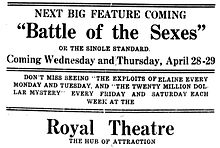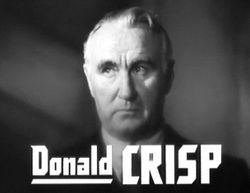The Battle of the Sexes (1914 film)
The Battle of the Sexes is a 1914 American silent drama film directed by D. W. Griffith for the Majestic Motion Picture Company. No complete prints of the film are known to exist, however, a fragment has survived. Griffith remade the film as The Battle of the Sexes in 1928 as a dramedy and this latter version is available on DVD.
The Battle of the Sexes was the second D. W. Griffith feature to be released to the public, following Biographs longdelayed release of Griffiths first feature, Judith of Bethulia, by barely more than a month. He had already begun The Escape 1914, but production had been stopped by actress Blanche Sweets spell of scarlet fever, and the RelianceMajestic Studio was already in trouble and in need of a viable Griffith property, fast. Griffith decided on a scenario entitled The Single Standard, written by inhouse screenwriter Daniel Carson Goodman and filmed at the Reliance studio in New York City, rather than at the Hollywood studio, which was still being built. According to Lillian Gish, The Battle of the Sexes was shot in only five days. Although the film was complete by February, its release was delayed two months more. Several reasons have been advanced for the impasse, but scholar Paul Spehr has suggested that both RelianceMajestic and its distributor, Mutual, were having difficulty developing an effective distribution strategy for longer, multireel films in a market still dominated by one and tworeel subjects. The Battle of the Sexes was premiered at Webers Theater in New York City on April 12, 1914, and was a considerable success the first one Griffith enjoyed with his name over the title.Although routinely listed as a lost film, Iris Barry had mentioned the existence of a short fragment of it in her 1940 monograph on Griffith. The surviving scene takes place in a restaurant, where Mrs. Andrews and the children take a booth and the children note that Mr. Andrews and Cleo are seated at the one next to them. Mrs. Andrews hasnt noticed, and the children find an excuse to get her out of there just before scene ends. Were there a minute or two more of this fragment extant, we may have seen Rudolph Valentino in his alleged screen debut in the bit part of a taxi dancer he is known to have played as an extra in an early Griffith feature, and a shadowy figure
Source: Wikipedia



